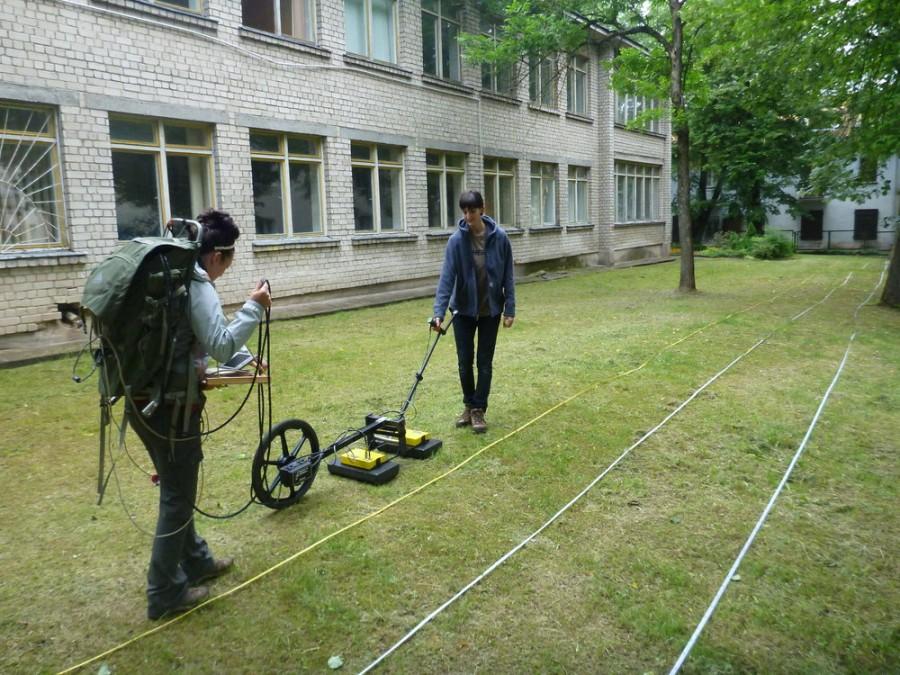Unexpected research opportunity gives Blugold student a chance to present internationally recognized discoveries
UW-Eau Claire senior joined professor in discovering remnants of an ancient synagogue
More stories from Hailey Novak
Photo by SUBMITTED
When Senior Alexis Pingel first enrolled in the introduction to geomorphology course at UW-Eau Claire, she had no idea she would soon be helping uncover remains of The Great Synagogue in Vilnius, Lithuania.
She found a way to take her love for the environment and her desire to travel to not only advance her skills as an undergraduate student, but also become part of an internationally-recognized discovery.
Pingel found herself in geomorphology last spring as an elective for her environmental biology major, and it was there where she first realized her passion was not so much for biology, but rather environmental geography.
At the beginning of the course, she and her classmates were required to hand in a resume which was then used by anthropology and geography professor Harry Jol to pass along for potential opportunities for his students.
After looking at her resume, Jol noticed Pingel had experience traveling and working outdoors. This included a study abroad trip to Australia and volunteer work with a club through DeLong Middle School called Miss Adventure Girls, where she works to help girls build confidence and self-esteem through activities such as camping.
Pingel said Jol looks for women to participate in these opportunities to develop their scientific background.
“There’s a lack of women in the STEM sciences who need to gain experience in their fields,” Jol said.
The research group isn’t funded through Eau Claire, but Pingel said he was fortunate enough to earn a scholarship from the Geography Foundation, which helped Pingel fund the trip’s expenses. In addition, Pingel received funding from Richard Freund, a member of the research team and professor at the University of Hartford (Conn.).
“A year ago at this time I hadn’t even considered doing any kind of undergraduate research,” Pingel said.
John Seligman of Israel Antiquities Authority, a government responsible for enforcing The Law of Antiquities in 1978 led the research group. One other female undergraduate student accompanied the trip – Nicole Awad from the University of Hartford helped specifically with the excavation process.
The group headed to Lithuania for seven days in June, 2015 to use ground-penetrating radar, more commonly referred to as GPR, to locate remains of The Great Synagogue. The GPR unit uses radar pulses to compose images of the subsurface.
Pingel was in charge of operating the GPR unit, mapping the grids and choosing which areas the group would look at. A school now sits on top of the former synagogue and Pingel said the group faced challenges working around the building and parking lots.
“Alexis gained an ability to work on a team, become innovative and also be respectful of other cultures all while gaining confidence to the point that she could run the survey by herself,” Jol said.
Originally built in the 17th century, The Great Synagogue was the oldest monument of Jewish culture in Lithuania. The Nazis destroyed it during World War II, and the Soviets later completely demolished it in 1955.
Pingel said she didn’t fully comprehend the synagogue’s impact on the Lithuanian community until she arrived and saw the locals’ reaction to the team’s discoveries.
“It was really shocking, over the course of five days, how much I realized the synagogue meant to the people in the community,” Pingel said.
During the 19th century in Vilnius, 40 percent of the population was Jewish. The synagogue was not just a place to worship, but also a place to spend a majority of their time as a religious community.
Pingel said she connected most to the project during the group’s visit to the site of the Ponary Massacre right outside Vilnius. Nearly 75,000 Jews were murdered during the Holocaust, including late family members of Seligman, head of the research team.
“I had never learned much about that part of the Holocaust before but that’s really when it hit me,” Pingel said.
After collecting data with the GPR, the group sent the data to be processed, and detected a portion of the synagogue’s wall in the subsurface images. This discovery alone was enough evidence to grant the team the opportunity to begin excavation during the summer of 2016.
Pingel said the team’s discovery began to receive worldwide press and she was invited to present her findings on The Great Synagogue at the Association of American Geographers conference on Oct. 15 in the Davies Center’s Dakota Ballroom.
“I’m presenting by myself for the first time so I’m not really sure what to expect, but I’m looking forward to working with professionals and getting a real world experience outside of school,” Pingel said.
In addition to her research experience in Lithuania, Pingel was given an opportunity to continue working with Jol on a different project the following month.
Pingel traveled with Jol in July to Superior where she once again utilized GPR to look at the subsurface of the Duluth Barrier System, which is the largest occurring fresh water barrier system.
In addition to Pingel’s love for the environment, she is also an active member of the Delta Zeta sorority on campus.
“When I first joined many people didn’t think I fit the sorority girl stereotype and people were surprised to find out that we’re actually big into academics,” Pingel said.
Pingel spends her free time doing philanthropy for the Starkey Hearing Foundation in Eden Prairie. Pingel said the sorority is currently working on a five-year plan to raise five million dollars for the foundation.
While Pingel said she still isn’t sure of an exact career she wishes to pursue, she knows someday she would like to work with the DNR or experiment with Geographic Information System mapping, and said she isn’t ruling out continuing to do geographical research in the future.


